The body has a variety of fuel sources it can use, all with different benefits and downsides.
Sugar, for example, is typically our primary energy source — not because it is the most efficient — but because it can be used rapidly by every cell in the body. Unfortunately, we sacrifice efficiency for speed when we burn sugar, which leads to the formation of potentially harmful molecules called free radicals.
Conversely, when carb intake is limited, we began using more efficient fuel sources that provide us with more energy (at a slower pace) without producing so much metabolic waste. Arguably, the most efficient energy source that our body can use is ketones. While BHB isn’t technically a ketone, it affects the body in the same way ketones do so we will be classifying it as one from here on out.
Of the two ketone bodies we use for fuel (acetoacetate and BHB), BHB provides us with the most energy while also benefitting our bodies in a plethora of different ways.
In this article, we will break down everything you need to know about BHB, from the in-depth science to real-life application:
- What Is Beta-Hydroxybutyrate (BHB)?
- How Your Body Produces and Uses BHB
- Why Does Your Body Bother with BHB? From an Evolutionary Perspective
- Why Does Your Body Bother With BHB? From a Mechanistic Perspective
- BHB Vs. Glucose: What Is the Better Fuel?
- Ten Benefits of Beta-Hydroxybutyrate (BHB) That Will Enhance Your Health
- How to Optimize Your BHB Levels
- Exogenous Ketosis: BHB Ketone Supplements
- The Fastest Way to Sustainable Ketosis and BHB Production
- How to Check Your Beta-Hydroxybutyrate (BHB) Levels
- Downsides of Having High BHB Levels
- Key Takeaways — Everything You Need to Know about BHB
What Is Beta-Hydroxybutyrate (BHB)?
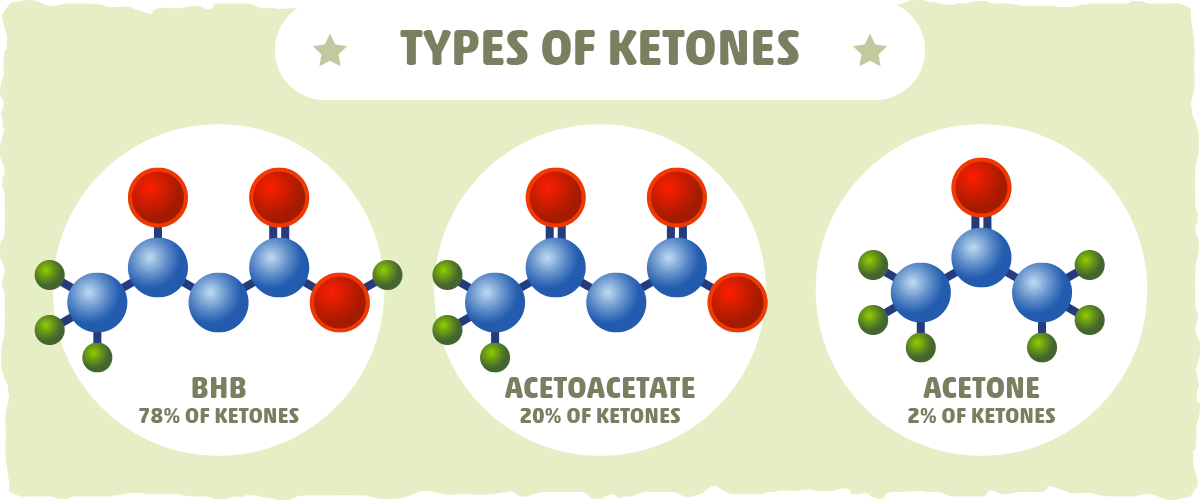
Beta-hydroxybutyrate (BHB), is one of the three ketone bodies your liver makes when it’s running low on carbs. (It is also known as 3-hydroxybutyric acid or 3-hydroxybutanoic acid or 3HB.)
Here is a brief overview of the ketone bodies that your liver can produce:
- Beta-hydroxybutyrate (BHB). This is the most abundant ketone in the body, typically making up ~78% of ketones found in the blood. BHB is the intended final product of ketogenesis (more on this later).
- Acetoacetate. This ketone body makes up around 20% of ketones in the blood. BHB is created from acetoacetate and cannot be produced by the body in any other way. It is important to note that acetoacetate is less stable than BHB, so it can be spontaneously converted into acetone before the acetoacetate-to-BHB reaction can take place.
- Acetone. The least abundant of the ketones; it makes up about 2% of ketones in the blood. It’s not used for energy and is excreted from the body almost immediately.
Both BHB and acetone are derived from acetoacetate, however, BHB is the main ketone used for energy because it’s extremely stable and abundant, while acetone is lost through respiration and sweat.
(Side note: There are left and right handed forms of BHB, called D- and L- BHB. Our body makes D-BHB and uses it for energy. We don’t normally make L-BHB, and if you consume this form, it does not get removed from the blood quickly and is not used as energy. Research suggests L-BHB might be directed into cholesterol synthesis in the body.)
Now that we know a bit about our ketone bodies, let’s take a closer look at the processes responsible for their production and usage.
The Road to Burning BHB: How Your Body Makes and Uses Ketones
The cycle of turning fats (and some amino acids) into BHB and BHB into energy involves two processes:
- Ketogenesis — The process by which BHB is produced in the liver. If we break down the name, it translates to “ketone” (keto-) “generation” (-genesis).
- Ketolysis — The process of transforming BHB into ATP (our primary molecule of energy transfer). It means “ketone” (keto-) “breakdown” (-lysis).
Both metabolic processes involve complex steps which we condensed below:
The Prequel to Ketogenesis: Lipolysis
To stimulate ketone production, a few things need to occur:
- Decreased insulin levels
- Increased glucagon levels
- Depleted glycogen stores
When all three are evident, conditions are ripe for lipolysis — the process of turning triglycerides (the molecule that is stored in your fat cells) into glycerol and free fatty acids.
Low insulin, increased glucagon, and depleted glycogen levels will trigger our fat cells to undergo lipolysis, freeing up fatty acids to travel through the blood. Some of the fatty acids will be used to fuel the cells while others will enter the liver, where they will be turned into BHB via a process called ketogenesis.
Ketogenesis — It’s Time to Make More Efficient Energy
The free fatty acids are then shuttled into the mitochondria of liver cells and cycled through the steps of ketogenesis:
- Acetyl-CoA formation: An essential piece of energy metabolism.
- Acetoacetyl-CoA: acetyl-CoA degrades into acetoacetyl-CoA.
- HMG-CoA: Acetoacetyl-CoA degrades into HMG-CoA.
- Acetoacetate: HMG-CoA turns into the first ketone, acetoacetate.
- BHB: Acetoacetate is reduced to BHB.
Side note: Depending on the energy and enzyme status of the liver cells, step 5 may not be completed. Instead, acetoacetate may spontaneously break down into acetone.
Ketolysis — Using Ketones for Fuel
All cells in our bodies can use ketones for fuel (except for the liver and red blood cells). They do this by using a process called ketolysis.
Once BHB (or acetoacetate) is released into circulation, your heart, brain, and other organs absorb it to turn it into energy. To do this, the cells reverse (for the most part) the process used to form the ketone bodies:
- BHB: BHB enters the mitochondria.
- Acetoacetate: BHB is converted back into the first ketone.
- Acetoacetyl-CoA: Acetoacetate is turned back to this molecule.
- Acetyl-CoA: Acetoacetyl-CoA turns back to acetyl-CoA, which can enter the Krebs cycle where it will be used to create energy.
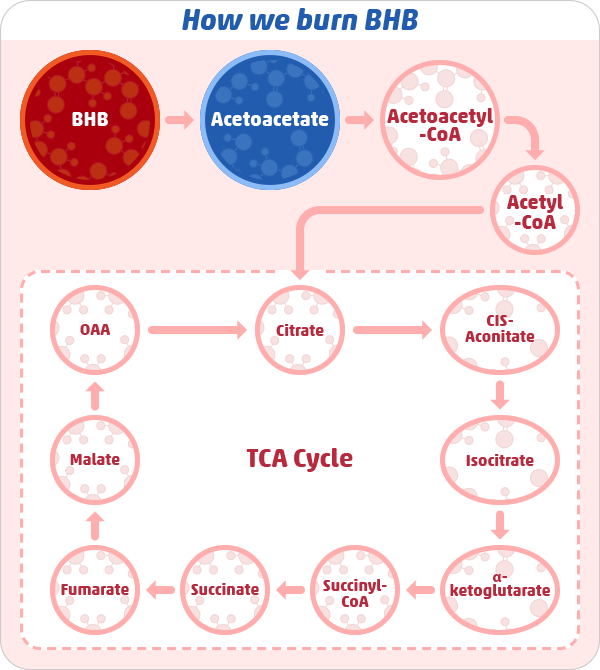
In the Krebs Cycle: Acetyl-CoA completely oxidizes, and this oxidation releases electrons into carrier molecules: NADH or FADH2.
And, finally, to produce energy: The electrons from NADH or FADH2 are transferred in a way that creates ATP. (This is also called the mitochondrial respiratory chain.)
As you can see, using BHB for energy is an elaborate process. In summary, acetyl-CoA is converted into BHB (in the liver), so we can have an energy-shuttling molecule for the cells that need it. Then, once BHB reaches the cells, it is transformed back into acetyl-CoA so that the cells can make usable energy (ATP).
Why Does Your Body Bother with BHB? From an Evolutionary Perspective
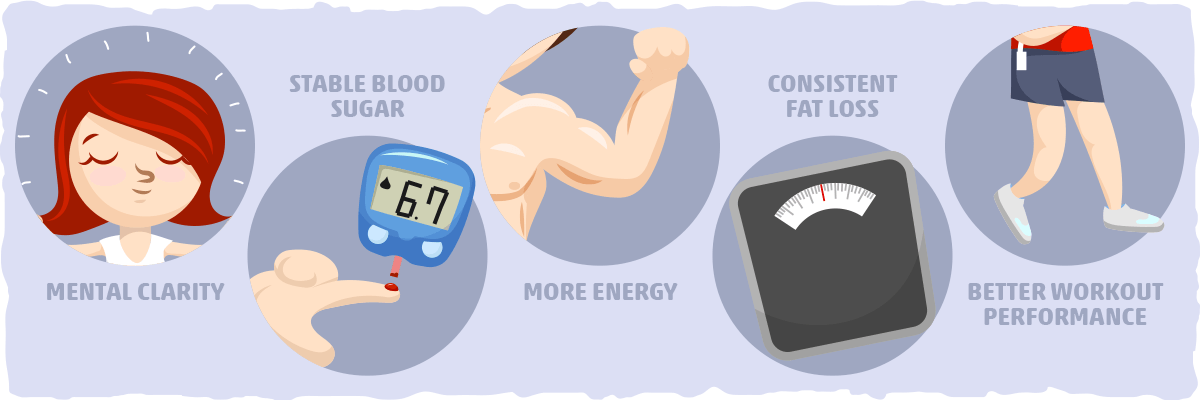
Doesn’t it seem like your body goes through a lot just to create and use one measly ketone body? Can’t it burn fat instead? Well, yes and no.
Fatty acids can be used for fuel in most cells, but it is simply too slow to fuel the brain. The brain needs fast acting energy sources, not a slowly metabolized fuel like fat.
Because of this, the liver developed the ability to convert fatty acids into ketones — an alternative energy source for the brain when sugar is running low. Some of you science nerds may be thinking: “Can’t we use gluconeogenesis to provide sugar for the brain?”
Yes, we can — but, we would have to break down ~200 grams (almost 0.5 pounds) of muscle per day and convert it into sugar just to fuel our brains when carbs aren’t available in high enough quantities.
By burning ketones for fuel instead, we can preserve our muscle mass, feed our brains, and live for longer periods of time when food is scarce. In fact, ketogenesis can help cut down the amount of lean mass lost during fasting by 5-fold.
Put in another way, using ketones for fuel reduces our need to burn muscle from 200 grams to 40 grams per day when food is scarce. When you are following a keto diet for weight loss, however, the amount of muscle you lose will be even less than 40 grams per day because you will be providing your body with muscle preserving nutrients like protein.
After a few weeks to months of being in nutritional ketosis (when your ketone levels are between 0.5 and 3 mmol/L), ketones will supply up to 50% of your basal energy requirements and 70% of your brain’s energy needs. This means that you will preserve even more muscle while you reap all of the benefits of ketone burning:
- Increased cognitive function and mental clarity
- Stable blood sugar
- More energy
- Consistent fat loss
- Better exercise performance
Key Takeaway: BHB serves as the only alternative fuel that the majority of our brain cells can use to replace sugar. By using BHB, it allows us to conserve muscle mass and experience numerous health benefits.
Why Does Your Body Bother With BHB? From a Mechanistic Perspective
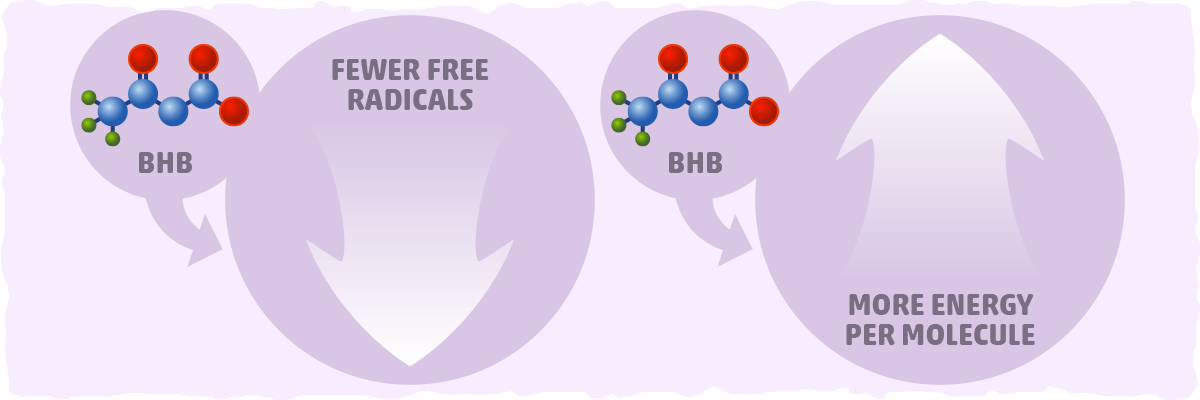
Not only does BHB help us prevent muscle wasting, but it also serves as a more efficient fuel than sugar in two ways:
- It produces fewer free radicals.
- It provides us with more energy per molecule.
Energy Production and Free Radicals: Glucose (Sugar) Vs. BHB
When we create energy, harmful by-products called free radicals (or oxidants) are formed. These by-products can damage cells and DNA when they are allowed to accumulate chronically.
During the production of ATP, oxygen and hydrogen peroxide are leaked. These are free radicals that can be easily countered with antioxidants.
However, they also have the potential to run wild and turn into the most damaging free radicals (i.e., reactive nitrogen species and hydroxyl radicals), which are responsible for most oxidative damage in the body.
Therefore, it is essential for optimal health to minimize chronic free radical accumulation. To do this, we must use cleaner-burning energy sources whenever possible.
Glucose and Free Radical Production
Glucose goes through a slightly longer process than BHB before entering the Krebs cycle to produce ATP. After the process is complete, 4 NADH molecules are created and the ratio of NAD+/NADH decreases.
NAD+ and NADH are worth noting because they regulate oxidant and antioxidant activity:
- NAD+ protects against oxidative stress, especially any issues caused by one of the oxidants mentioned earlier: hydrogen peroxide. It also enhances autophagy (the cleaning and renewal process of damaged cell parts). As a result of various metabolic processes, NAD+ turns into NADH to be used as an electron shuttle for energy production.
- NADH is also necessary because it provides electrons for ATP production. However, it doesn’t protect against free radical damage. When there’s more NADH than NAD+, more free radicals are produced and protective enzymes are inhibited.
In other words, it is best if the ratio of NAD+/NADH stays high in most cases. Low NAD+ can lead to serious oxidative damage in the cell.
Since glucose metabolism consumes 4 NAD+ molecules, it tips the scale towards more NADH, which can cause more oxidative damage. Put more succinctly: glucose does not burn cleanly — especially when compared to BHB.
BHB and Free Radical Production
BHB does not go through glycolysis. All it needs to do change back into acetyl-CoA before entering the Krebs cycle. Altogether, this process only consumes 2 NAD+ molecules, making it 2x more efficient than glucose from the perspective of free radical production.
Research also shows that BHB not only preserves but also increases the NAD+/NADH ratio. This means that BHB can:
- Protect against oxidative stress and oxidants created during ketolysis
- Support mitochondrial function and reproduction
- Provide anti-aging and longevity effects
BHB also acts as an antioxidant by activating protective proteins:
- UCP: This protein neutralizes the free radicals that leak during energy metabolism, preventing oxidative damage in the cell.
- SIRT3: When your body switches from glucose to fats, a protein called Sirtuin 3 (SIRT3) increases. It activates powerful antioxidants that keep free radicals low during energy creation. It also stabilizes the FOXO genes, which protect against oxidation.
- HCA2: BHB activates this receptor protein as well. Many studies suggest that this explains BHB’s neuroprotective effects.
How Much Energy Do We Get from Glucose?
According to the current literature, one molecule of glucose makes about 30-34 molecules of ATP. (It was widely taught that the yield was 36-38 ATP, but updated sources found that the old belief was an overestimation.)
The official change in free energy (∆G) is -7.3 kcal/mol. In other words, each molecule of ATP from this reaction generates roughly 7.3 kilocalories.
When we put this info together, we come up with 248 kilocalories as the total energy released from one glucose molecule. (34 ATP * 7.3 kilocalories =248 kilocalories.)
How Much Energy Do We Get from BHB?
One molecule of BHB makes around 21.5 molecules of ATP, lower than what we get from one molecule of glucose. However, according to multiple studies, BHB generates a change in free energy of -13 kcal/mol, which is almost double the amount that we get from glucose.
Altogether, this means that we get about 279 kilocalories of total energy released from one BHB molecule.
Putting It All Together — BHB Vs. Glucose: What Is the Better Fuel?
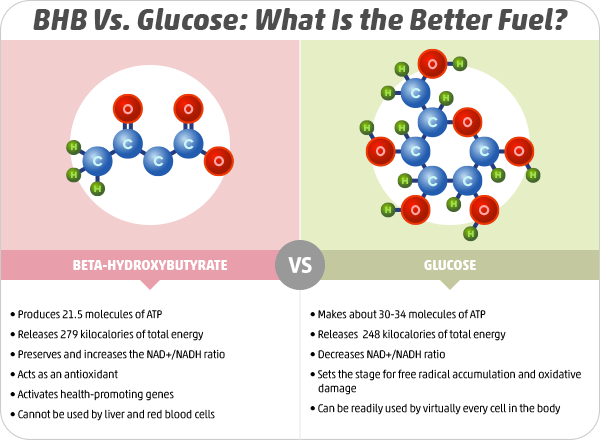
When we consider the efficiency of BHB and glucose, it seems like BHB is the ideal fuel. It produces fewer free radicals and acts as an antioxidant while also providing us with a bit more energy per molecule.
What’s even more fascinating about BHB is the effects that it has throughout the body. Not only is BHB a highly efficient fuel, but it provides us with a plethora of benefits as well.
Ten Benefits of Beta-Hydroxybutyrate (BHB) That Will Enhance Your Health
Although the research on how BHB affects the body is still in its infancy, scientists have already discovered at least ten benefits of using this alternative fuel source:
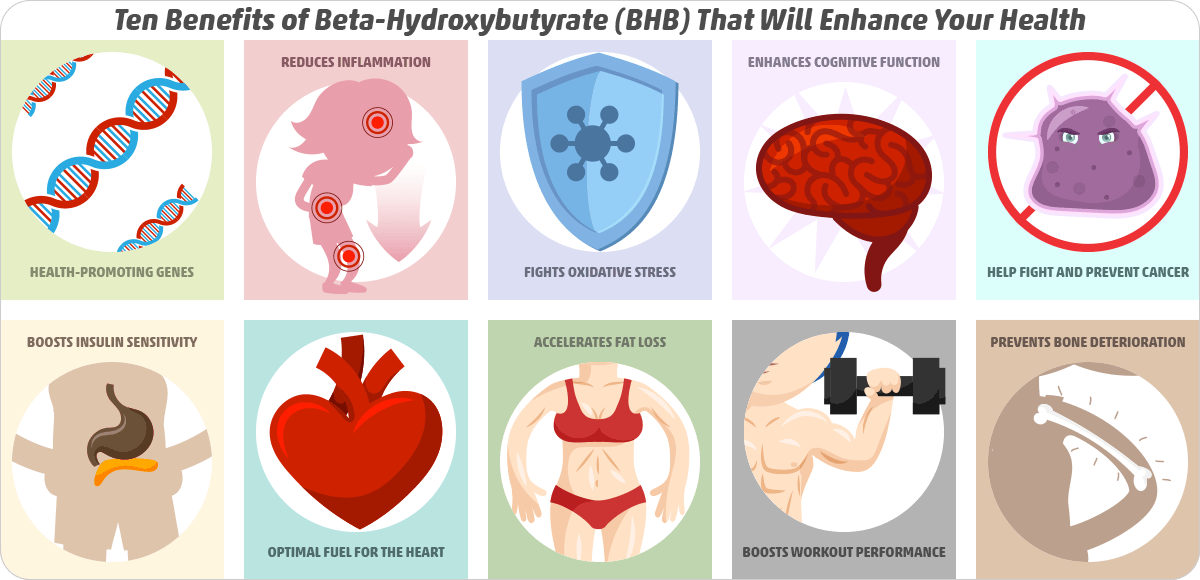
1. BHB stimulates the expression of various health-promoting genes.
BHB acts as a “signaling metabolite” that stimulates various epigenetic changes throughout the body. In fact, a lot of BHB’s benefits come from its ability to optimize the expression of your genes. For example, BHB inhibits molecules that silence powerful proteins. This makes helpful genes, such as FOXO and MTL1, available for expression.
The activation of FOXO allows us to regulate oxidative stress resistance, metabolism, cell cycles, and apoptosis much more effectively, which has a positive effect on our longevity and vitality. On top of that, MLT1 helps to reduce toxicity after BHB stimulates its expression.
These are only two examples of the genetic impact that BHB has on our cells. Scientists are still discovering more of what these miraculous molecules can do.
2. BHB reduces inflammation.
BHB blocks an inflammatory protein called NLRP3 inflammasome. NLRP3 unleashes inflammatory molecules that are meant to help the body heal, but when they are chronically stimulated, they can trigger cancer, insulin resistance, bone diseases, Alzheimer’s disease, skin diseases, metabolic syndrome, type 2 diabetes, and gout.
Many studies have found that BHB can reduce inflammation related to these conditions, making it useful for preventing diseases triggered or aggravated by inflammation.
For example, BHB (and the keto diet) may help treat gout and prevent gout attacks by inhibiting NLRP3.
3. BHB fights oxidative stress.
Oxidative stress is associated with accelerated aging and various chronic health conditions. One way to mitigate these issues is by using a more efficient fuel source like BHB.
Not only is BHB more efficient than sugar, but research has also found that can prevent and reverse oxidative damage throughout the brain and body:
- In the hippocampus, the part of your brain that regulates emotions, long-term memory, and spatial navigation, BHB protects the integrity of neuronal connections against oxidative damage.
- In the neocortex, the brain area responsible for higher-order functions like cognition, spatial reasoning, language, and sensory perception, BHB protects nerve cells from free radicals and oxidation.
- In endothelial cells (cells lining the inside of your blood vessels), ketones activate antioxidant defenses that protect the cardiovascular system.
- In athletes, ketone bodies have been found to reduce the oxidative stress caused by exercise.
4. BHB can increase longevity.
By eliciting the two benefits we learned about earlier (inflammation reduction and gene expression), BHB can add more years to your life and life to your years.
This is how BHB taps into your anti-aging genes:
- Blocks the insulin-like growth factor (IGF-1) receptor gene. This gene boosts cell growth and proliferation, but excessive growth is linked to diseases, cancer, and early death. Lower IGF-1 activity delays aging and increases lifespan.
- Activates FOXO genes. One particular FOXO gene, FOXO3a, is linked to increased longevity in humans because it boosts antioxidant production.
5. BHB enhances cognitive function.
Earlier we discussed how BHB is an essential fuel source for the brain when sugar is running low. This is because it can easily cross the blood-brain barrier and provide your brain with over 70% of its energetic needs.
However, the benefits of BHB for the brain don’t stop there. BHB also improves cognitive function by:
- Acting as a neuroprotective antioxidant.
- Increasing mitochondrial efficiency and reproduction.
- Improving the balance between inhibitory and excitatory neurotransmitters.
- Encouraging the growth and differentiation of new neurons and neuronal connections.
- Preventing brain atrophy and plaque build up.
If you’d like to take a closer look at how BHB benefits the brain and the research behind it, check out our article on ketones and the brain.
6. BHB can help fight and prevent cancer.
BHB can slow down the growth of various tumors because most cancer cells can’t use ketones well enough to grow and spread. This is typically due to the fact that cancer cells tend to have impaired metabolic function, causing them to depend predominantly on sugar.
In various studies, scientists exploited this weakness by taking away glucose and forcing cancer cells to depend on ketones. By doing so, they actually decreased tumors in many organs including the brain, pancreas, and colon, because the cells were unable to flourish and spread.
However, it is also important to note that not all cancers behave in the same way and BHB will not help fight and prevent ALL cancers. If you’d like to take a closer look at the research on ketones, ketogenic diet, and cancer, check out our article on the topic.
7. BHB boosts insulin sensitivity.
Ketones may help reverse insulin resistance by mimicking some of the effects of insulin and keeping blood sugar and insulin levels under control. This is promising for anyone who is struggling with prediabetes or type 2 diabetes — or anyone who wants to improve their metabolic health in general.
8. BHB is an optimal fuel for the heart.
The heart’s preferred energy source is long-chain fatty acids. That’s right — your heart burns fat, not ketones, as its primary fuel source.
However, just like the brain, your heart can adapt remarkably well to ketones if needed.
Studies have found that, while burning BHB, heart health will improve in many ways:
- Mechanical efficiency of the heart can increase by up to 30%
- Blood flow can increase by up to 75%.
- Oxidative stress in the heart cells decreases.
Altogether, this means that BHB may be the best fuel for your heart.
9. BHB accelerates fat loss.
Burning ketones for fuel can help boost your fat loss in two ways:
- By increasing your fat- and ketone-burning capacity.
- By suppressing your appetite.
As you sustain ketosis, your ability to burn more ketones and fat will improve significantly, turning you into a fat burning machine. Along with that, you will also experience that appetite suppressing effects of ketones.
Although the research has not found out exactly why or how ketones decrease our appetite, we do know that increased ketone burning seems to reduce ghrelin levels (the hunger hormone).
When we combine these two effects of BHB on weight loss, we end up with a fuel that will promote fat burning and keep you from gaining fat (by preventing excess calorie consumption) at the same time.
10. BHB enhances workout performance.
Many studies have been done on how BHB affects exercise performance, but the nitty-gritty details are still being worked out (pun intended). In short, ketones have been found to:
- Improve performance during low to moderate intensity endurance exercises (e.g., cycling, hiking, dancing, swimming, power yoga, playing sports, walking long distances).
- Increase fat burning and preserve glycogen stores for high-intensity exercises.
- Help to indirectly replenish glycogen stores after exercise and accelerate recovery.
- Decrease fatigue and improve cognitive function during activity.
In general, the research indicates that BHB can help decrease fatigue, increase endurance, and potentially enhance overall exercise performance. However, it will not boost your performance for high-intensity activities like sprints and heavy weightlifting. (To learn why this is the case, feel free to check out our guide to exercising on keto.)
Bonus Benefit: BHB Prevents Bone Deterioration
In my opinion, the most surprising effect that BHB has on the body is what it does to our bones.
Research has found that BHB:
- Prevents bone degradation by stopping the production of osteoclasts (cells that break down bone) in subjects with osteoporosis.
- Prevents bone density decline.
- Increases resistance to bone deformation
- Improves the volume of internal bone tissue (called cancellous or spongy bone).
How to Optimize Your BHB Levels to Reap Its Benefits
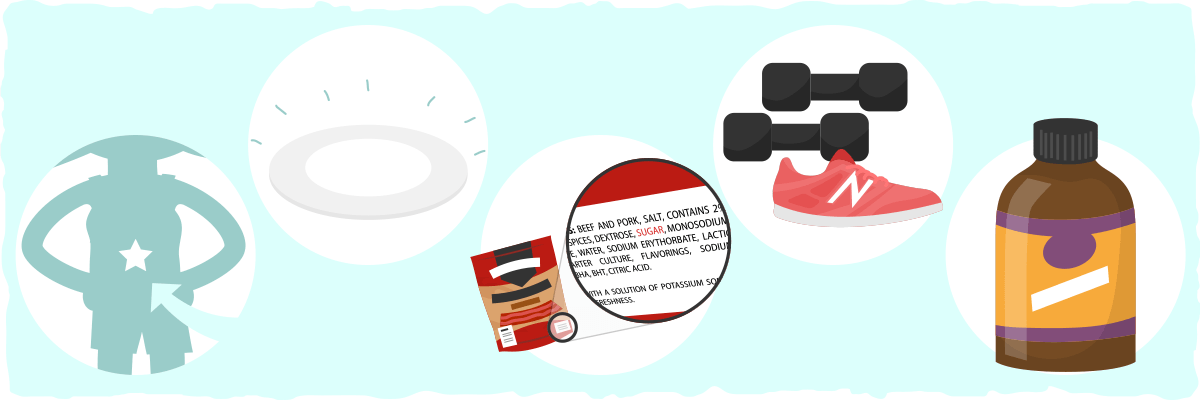
There are two ways to increase your BHB levels: endogenously and exogenously.
Endogenous BHB is the one your body makes by itself.
Exogenous ketones are external BHB molecules you can take as a supplement to raise ketone levels right away. These are usually taken in the form of BHB salts or esters.
The only way to truly optimize AND sustain your ketone levels is by producing them endogenously. Exogenous ketone supplementation can help, but it will never replace the benefits of sustained nutritional ketosis.
The Best Strategy: Optimizing BHB Levels Endogenously
The only way to sustain ketosis and remain healthy for the long term is by following the ketogenic diet. Other diets and methods can promote transient ketone production, but keto is the only method that will allow you to maintain ketosis consistently.
Typically, keto dieters will get 60-80% of their calories from fat, 15-35% of their calories from protein, and 5-10% of their calories from carbs. By eating in this way, we stimulate ketone production to the point that blood ketones stay between 0.5 and 3.0 mmol/L — an amount that allows us to reap the benefits of BHB.
Here is a brief overview of what you should and shouldn’t eat on the keto diet:
Do Not Eat
- Grains – wheat, corn, rice, cereal, etc.
- Sugar – honey, agave, maple syrup, etc.
- Fruit – apples, bananas, oranges, etc.
- Tubers – potato, yams, etc.
Do Eat
- Meats – fish, beef, lamb, poultry, eggs, etc.
- Low Carb Vegetables – broccoli, cauliflower, spinach, kale, and other low-carb vegetables >
- High Fat Dairy – hard cheeses, high fat cream, butter, etc.
- Nuts and seeds – macadamias, walnuts, sunflower seeds, etc.
- Avocado and berries – raspberries, blackberries, and other low glycemic impact berries
- Sweeteners – stevia, erythritol, monk fruit, and other low-carb sweeteners >
- Other fats – coconut oil, high-fat salad dressing, saturated fats, etc.
To see more specific advice on what (and what not) to eat, click here >
I also recommend checking out our keto recipes and using our keto calculator to help keep you on track to getting the results you want.
There are also three other strategies you can use to boost your endogenous BHB production even further:
Intermittent Fasting
Any form of fasting will stimulate ketone production. Even after an overnight fast, your body will start producing BHB. If you extend your overnight fast even longer, BHB levels will only continue to increase.
One of my favorite ways to use this phenomenon to boost my ketone production is by following a simple intermittent fasting protocol. Unlike regular fasting (not eating for several days), intermittent fasting is done for just a portion of the day, and it gives you similar health benefits.
There are several ways to do intermittent fasting, but the most common is to eat in a limited time window during the day and fast during the remaining hours. Typically, keto dieters will fast for 16 hours a day and eat in an 8-hour window. For example, you could fast from 07:00 pm to 11:00 am, and eat from 11:00 am to 07:00 pm.
By combining a ketogenic diet with an intermittent fasting protocol that fits your lifestyle, you’ll be able to run on ketones more quickly and easily. To learn more about this fasting method, check out our guide to intermittent fasting.
Avoiding Hidden Carbs
Our food environment is filled with carbs. You will find carbs lurking in “healthy” snacks, beverages, restaurant meals, and in almost every processed food item.
If you are not careful, you can easily surpass the daily carb limit you need to eat to stay in ketosis, which is usually around 35 grams.
Here are some simple strategies you can use to avoid hidden carbs:
- Stick to real food. Avoid packaged snacks and drinks as often as possible.
- Always read labels at the supermarket.
- Research the carb content of any foods that don’t have labels.
- Cook at home more often. Use our keto recipes for some delicious meal ideas.
- When dining out, use our guide for on-the-go keto.
- Calculate the net carbs in your food before eating it. If it doesn’t fit within your carb limit, then avoid it.
Exercise
Exercise can increase BHB levels in many ways, depending on the activity that you do.
Low-to-moderate intensity exercise, like walking, cycling, or power yoga, can help increase lipolysis and fat burning. For example, by taking a morning walk, you will increase your fat burning capacity while providing your liver with the fatty acids it needs to make ketones.
On the other hand, high-intensity exercise, like heavy weight lifting, CrossFit training, or sprinting, can drain your glycogen stores to the point when your liver has to use gluconeogenesis and ketogenesis to fuel the body.
To get into ketosis as quickly as possible, it is best to exercise at high-intensity for 45 min to an hour to start off your keto diet (before you even eat your first meal). This will drain your glycogen levels and set the stage for ketosis.
Then, during the next couple of days of keto dieting, make sure you do some form of low-to-moderate intensity activity for at least 30 min each day. This will increase the amount of fat you burn and provide your liver with more fatty acids that it can turn into ketones — especially if you do low-to-moderate intensity activity before your first meal.
Whether you decide to follow this workout strategy or not, the key takeaway from this section is that exercise is a powerful tool. Not only is it crucial for optimal health, but it will help boost your endogenous ketone production as well. It doesn’t matter what kind of exercise you do, just get out there and move your body!
Take An MCT Oil Supplement
Unlike exogenous ketone supplements, MCT oil promotes endogenous ketone production. This supplement consists of medium chain triglycerides that provide your liver with the substrates it needs to create ketones. You can take it in any time you want to give yourself a quick BHB boost.
If you would like to learn more about MCT oil supplements, check out our guide to MCTs. If you’d like to order an MCT supplement yourself, we recommend and use this brand (use coupon RULEDME for 15% off).
Now that we covered the many ways of sustaining and promoting endogenous ketosis, let’s take a look at using exogenous ketone supplements:
Exogenous Ketosis: Everything You Need to Know about BHB Ketone Supplements
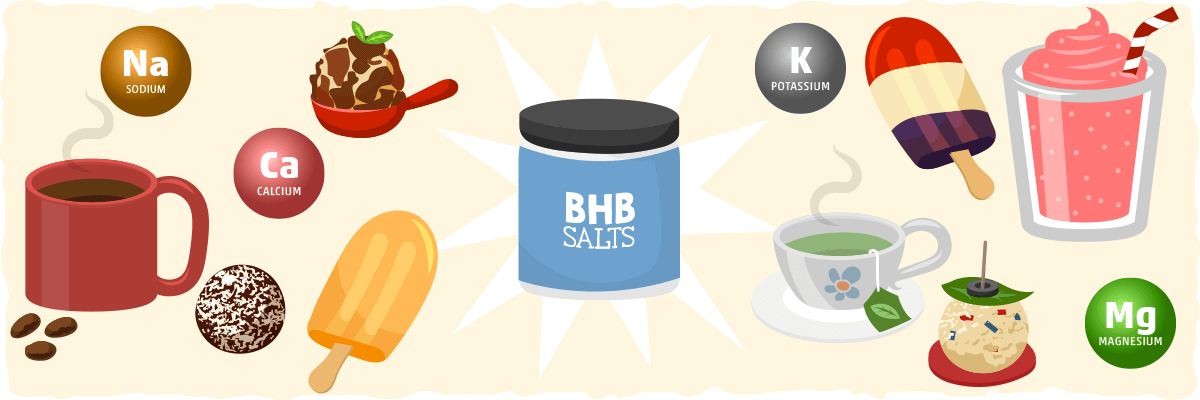
There are two common ways to get exogenous ketones: BHB salts and ketone esters.
Ketone esters are the raw form of BHB, with nothing else added. They are expensive, hard to find, taste terrible, and may negatively affect the gastrointestinal system.
BHB salts, on the other hand, are a highly effective supplement that is easier to purchase, consume, and digest. These ketone supplements are typically made from a combination of BHB and mineral salts (i.e., potassium, calcium, sodium, or magnesium).
The mineral salts are added to exogenous BHB supplements to:
- Buffer the intensity of the ketones
- Improve the taste
- Lower the incidence of stomach issues
- Make it mixable with food and drinks
When you take BHB salts, they’re broken down and released into your bloodstream. BHB then travels toward your organs, where it starts undergoing ketolysis to provide you with energy.
Depending on how much you take, you will enter into ketosis almost immediately. However, you will only stay in ketosis for as long as those ketones last (unless you are on the keto diet and are already producing ketones endogenously).
Are BHB Salts Safe?
Many trials on humans and animals indicate the BHB salts are safe. Most exogenous BHB supplements contain 11-16 grams of BHB, which is an effective dose that doesn’t cause any major side effects.
As long as your blood BHB remains at a level of nutritional ketosis (0.6-3 mmol/L), then supplementing with ketone salts shouldn’t cause any issues. As with any other supplement, consult with your doctor before adding BHB salts to your diet.
For more information on the safety and potential side effects of BHB salts, check out our post on Keto Os — one of the most popular ketone salt supplements on the market.
How To Choose The Best BHB Salts for You
When finding the best BHB salts, make sure you do these three things:
1. Look for more BHB and fewer salts.
A high-quality supplement maximizes the exogenous BHB and adds only the amount of mineral salts that is necessary.
The most popular mineral salts used in the market are sodium, potassium, magnesium, and calcium, and most supplements use three of them, although some only use one or two.
Check the label and make sure the quantity of each mineral salt is below 1 gram. BHB salt blends rarely need to have more than 1g of each mineral to be effective.
2. Make sure you are getting the minerals you need.
Having trouble get enough potassium, sodium, calcium, or magnesium? Choose a BHB product that provides you with the minerals you need more of.
Use these recommended intakes as your guide:
Sodium
- 5 to 7 grams of unrefined salt per day
Potassium
- 3,500 mg per day for people ages 16 and up
Calcium
- 1,000 mg per day for people ages 4 and up
Magnesium
- For men: ~400 mg per day
- For women: ~310 mg per day
3. Stay away from fillers and added carbs.
Fillers and texture enhancers like guar gum, xanthan gum, and silica (also named silicon dioxide) are common in exogenous ketone salts, and completely unnecessary. They usually don’t have adverse health effects, but they rob you of precious BHB salts.
To get the purest ketone salts, simply look for the part of the nutritional label that says “other ingredients” and get the product with the shortest list of practical ingredients.
If you are purchasing flavored BHB ketone salts, make sure they only contain real ingredients and low carb sweeteners. Avoid any carb-ridden additives like maltodextrin and dextrose. This brand is our favorite to use (coupon code RULEDME will also give you 15% off).
How to Take BHB Salts
The beauty of BHB salts is you can add them to snacks and drinks or have them on their own.
Here are some keto drink examples you can add them to:
- Heavily dilute it in water to keep your hydrated and increase your ketone levels.
- Add your BHB salts to a keto smoothie like the Keto Tropical Smoothie or the Blueberry Banana Bread Smoothie.
- Ketoproof Coffee. Caffeine + BHB + Fat = one of the quickest ways to ketosis.
- Ketoproof Green Tea. Not a fan of coffee? Mix your BHB salts into green tea instead.
- For an added ketone boost, mix your BHB salts into any of these keto drinks with MCT oil powder.
Check out our guide to keto drinks for more low-carb drinks ideas.
Or you can add them to keto snacks:
- Fat bombs. Try adding them to one of the fat bombs in our fat bomb guide.
- Keto Mocha Mousse and Tropical Chocolate Mousse Bites can be a delicious way to fit some extra BHB into your diet.
- Add the appropriate flavored ketone supplement to one of our keto popsicle recipes, and you’re in for a treat: Berry Bomb Pops, Cinnamon Roll Pudding Pops, or Raspberry Lemon Popsicles.
When Should You Take BHB Salts? Fasting or with Food?
Whether you take BHB with your meal or not depends on personal preference. The BHB from the supplement will be digested and used by your cells regardless of when you consume it.
However, BHB salts can be most helpful when you are first starting or getting back on a keto diet. I find it best to use them as a way to provide me with energy and minerals that will remedy most, if not all, of my keto flu symptoms. The only downside is that they may reduce endogenous ketone production in the short term as well.
Putting It All Together — The Fastest Way to Sustainable Ketosis and BHB Production
As I mentioned earlier, the most sustainable way to get into ketosis is to stimulate ketogenesis (endogenous ketone production).
Although it is true that you can almost instantly enter ketosis by taking a dose of BHB salts, your body will eventually end up relying on its own fuel (i.e., carbs, fat, and/or ketones) when the exogenous ketones have been used. This is why it is crucial that you stimulate endogenous ketone production if you want to maintain ketosis and reap all of the benefits of BHB.
To stimulate long-term BHB production, you must follow the ketogenic diet. It is the only safe, healthy, and budget-friendly way of sustaining ketosis.
However, when you first start restricting carbs, you may experience mental fogginess, physical fatigue, and other keto flu symptoms as your body adapts to burning fat and ketones for fuel. This is when using the other strategies for increasing ketone production will help.
For example, if you deplete your glycogen levels with high-intensity exercise, encourage fat burning with low-intensity exercise, diligently avoid added carbs, and/or take ketone-boosting supplements when you need extra energy, then you will be able to enter ketosis much more quickly while remedying most, if not all, of your keto flu symptoms.
To further illustrate my point, here is what I believe is the fastest way to enter and sustain ketosis:
- Implement a very low carb ketogenic diet (less than 15 grams of net carbs per day would be ideal).
- On the morning of the first day of keto dieting, do a fasted high-intensity training session for 45 – 60 min.
- Intermittent fast for at least 14 hours (from your last meal).
- After your fast, have a very low carb keto meal and supplement with MCT oil and/or BHB Ketone Base when you need extra energy (taking both supplements together will raise your ketone levels the most).
- Do 20-30 min of low-to-moderate intensity exercise during the next few days, first thing in the morning.
- Implement intermittent fasting for the next few days as well
- Keep following your keto diet and supplement with MCT oil and/or exogenous ketones when needed.
Once you’ve reached the ketosis levels that you want to maintain, feel free to follow a less restrictive keto diet (between 20 – 30 grams of net carbs) and vary your intermittent fasting schedule, exercise routine, and supplementation strategy in any way that works best for you.
You now have most of the keys to ketosis, but one piece to the BHB puzzle is missing. We still need to figure out how to verify if we are producing BHB and what our BHB levels are when we are in ketosis.
How to Check Your Beta-Hydroxybutyrate (BHB) Levels
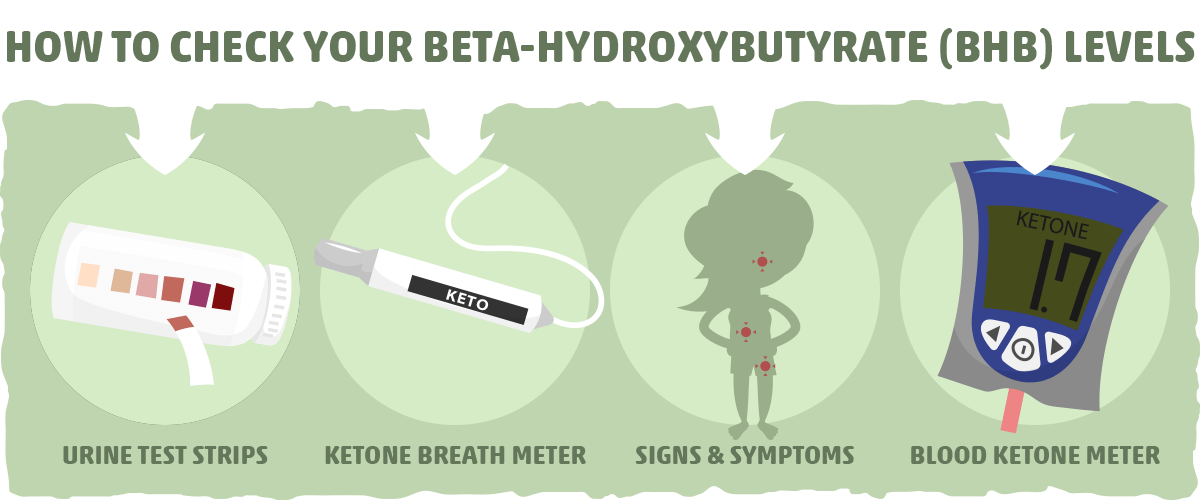
The only way to know if you’re running on BHB is by testing the ketone levels of your breath, urine, or blood. For a comprehensive guide on how to do this, check out our article on measuring ketosis.
For the purposes of this article, we will briefly take a look at the methods you can use to find out if you are in ketosis:
- Urine Test Strips. These strips are designed to detect the acetoacetate levels in your urine, which is associated with BHB levels. However, as you get better at producing and using ketones, the amount of acetoacetate that accumulates in your urine will decrease.
- Ketone Breath Meter. Simply by blowing into a breath meter, you can find out how much acetone you are excreting from your body. Just like with urine test strips, this is a reliable proxy measure for your BHB levels. However, as you become more keto-adapted, you will tend to produce less acetone and more BHB.
- Signs and Symptoms of Ketosis. There are several signs that indicate if you are producing ketones. This is the most indirect and inaccurate way of figuring out how much BHB you are producing, but it is also cheap and convenient. To learn what the common signs and symptoms of ketosis are, check out this article.
- Blood Ketone Meter. This is the gold standard for measuring your BHB levels. It measures the BHB in your blood directly, no guesswork needed. The blood ketone meter is cheap, but if you test your BHB levels often, the cost of the testing strips may end up breaking your budget.
If you want to get the most precise ketone measurements, then I recommend investing in a blood ketone meter. Conversely, for those of you who just want to know if you are in ketosis or not, using one of the other three strategies (i.e., urine test strips, ketone breath meter, or checking for signs of ketosis) will be all you need.
Most keto dieters will do just fine by simply eating the right keto macros and sticking to the diet.
Are There Any Downsides of Having High BHB Levels?
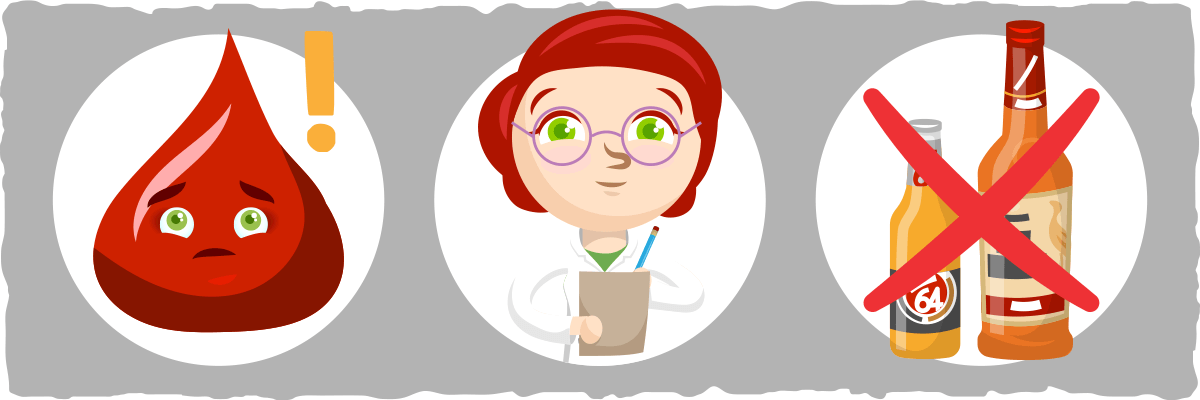
Other than the fact that BHB has a diuretic effect on the body that may increase your fluid and electrolyte needs, there are no other valid concerns. Even children can run on BHB without any issues. However, it is important to be aware of the most common issue that is related to ketone production.
BHB and Ketoacidosis
The most common concern doctors have when you start producing more ketones is that you may enter a potentially life-threatening state called ketoacidosis. However, this will only happen in diabetics (both type 1 and type 2) that are not keeping their blood sugar levels under control, in binge drinkers who have copious amounts of alcohol in their system and no other food or fluids, and individuals who are under extremely stressful situations (e.g., pregnancy combined with extreme caloric restriction). For more information on ketoacidosis, check out our comprehensive guide on the condition.
If your BHB levels are increasing as a result of following a ketogenic diet, then your body will most likely be able to keep your ketone levels under control. People who have diabetes may even benefit from being on a ketogenic diet and/or taking exogenous ketones because BHB can help lower blood sugar and improve insulin sensitivity.
However, it is absolutely crucial for diabetics to work with their healthcare practitioner if they want to supplement with ketone salts or start the keto diet. Both can cause significant changes in blood sugar levels and will require close monitoring at first.
On the other hand, if your blood sugar levels are normal, then your risk of developing ketoacidosis is extremely low — especially if you are on a keto diet.
For a quick reference point, your BHB levels should be around 0.5 – 3.0 mmol/L while you are on keto. Only if your BHB levels skyrocket to 15-25 mmol/L will you be in ketoacidosis.
Key Takeaways — Everything You Need to Know about BHB
There are three main types of ketone bodies that can be detected in the bloodstream during ketosis:
- Acetoacetate
- Beta-hydroxybutyrate (BHB)
- Acetone
BHB is the most efficient ketone produced and far more efficient than glucose. Not only does it provide more energy than sugar, but it does so while fighting oxidative damage, lowering inflammation, and improving the function of your organs (particularly your brain).
If you want to lose fat, increase cognitive function, and extend your lifespan, running on BHB is the way to go.
The simplest way to increase your BHB levels is by taking exogenous ketones and MCT oil. However, these supplements will only raise your ketone levels until your body uses them up.
To stimulate long-lasting BHB production in the healthiest way possible, you have to follow the ketogenic diet.
As you are implementing the diet, you can increase your ketone production even further by using a variety of strategies, including:
- Restricting your net carbs below 15 grams per day for the first week.
- Using high-intensity exercise to deplete glycogen stores.
- Using low-to-moderate intensity exercise as a way to increase fat burning and ketone production.
- Following an intermittent fasting schedule.
- Taking MCT oil supplements and/or BHB ketone salts when you need an energy boost. This is our favorite BHB supplement.
By following the keto diet and implementing these ketosis-boosting strategies, you will reap all of the benefits of being a ketone-burning machine.
Sources:
- What Are Ketones? Everything You Need to Know — Ruled.me
- This is How We Burn Ketones for Energy — Chris Masterjohn PhD
- Regulation of Ketone Body Metabolism and the Role of PPARα — NCBI
- Do ketogenic diets really suppress appetite? A systematic review and meta-analysis. — NCBI
- Ketone Bodies in Epilepsy — NCBI
- Malonyl-CoA: the regulator of fatty acid synthesis and oxidation — NCBI
- Ketosis as a treatment for multiple metabolic and neurodegenerative pathologies — Journal of Translational Science
- Effect of weight loss and ketosis on postprandial cholecystokinin and free fatty acid concentrations. — NCBI
- Beyond weight loss: a review of the therapeutic uses of very-low-carbohydrate (ketogenic) diets. — NCBI
- Breath acetone is a reliable indicator of ketosis in adults consuming ketogenic meals — The American Journal of Clinical Nutrition
- Ketone body metabolism — DiaPedia
- Ketone Bodies as Fuel — Humboldt State University
- Metabolic Energy — NCBI Bookshelf
- Brain Energy Metabolism: Focus on Astrocyte-Neuron Metabolic Cooperation — Science Direct
- Sugar for the brain: the role of glucose in physiological and pathological brain function — NCBI
- The β-hydroxybutyrate receptor HCA2 activates a neuroprotective subset of macrophages. — NCBI
- Interplay between oxidant species and energy metabolism — NCBI
- The biology of mitochondrial uncoupling proteins. — NCBI
- Mitochondrial uncoupling proteins and energy metabolism — NCBI
- Ketone-Based Metabolic Therapy: Is Increased NAD+ a Primary Mechanism? — NCBI
- Investigating mitochondrial redox state using NADH and NADPH autofluorescence — Science Direct
- Interplay between oxidant species and energy metabolism — NCBI
- Ketone bodies as signaling metabolites — NCBI
- Utilization of L(+)-3-hydroxybutyrate, D(-)-3-hydroxybutyrate, acetoacetate, and glucose for respiration and lipid synthesis in the 18-day-old rat. — NCBI
- Ketone Bodies Mimic the Life Span Extending Properties of Caloric Restriction — Wiley Online Library
- Beta-hydroxybutyrate: New Test for Ketoacidosis — Danbury Hospital
- 3-Hydroxybutanoic acid — PubChem
- Free radicals, reactive oxygen species, oxidative stress and its classification — Science Direct
- Glucose and reactive oxygen species. — NCBI
- BHB Patent — Patent Images
- Compositions and methods for producing elevated and sustained ketosis — Google Patents
- The effect of 3-hydroxybutyrate on the in vitro differentiation of murine osteoblast MC3T3-E1 and in vivo bone formation in ovariectomized rats. — NCBI
- The mechanism of anti-osteoporosis effects of 3-hydroxybutyrate and derivatives under simulated microgravity. — NCBI
- The Effects of Ketogenic Dieting on Body Composition, Strength, Power, and Hormonal Profiles in Resistance Training Males. — NCBI
- Ketone Body Infusion With 3‐Hydroxybutyrate Reduces Myocardial Glucose Uptake and Increases Blood Flow in Humans: A Positron Emission Tomography Study — Journal of the American Heart Association
- The therapeutic implications of ketone bodies: the effects of ketone bodies in pathological conditions: ketosis, ketogenic diet, redox states, insulin resistance, and mitochondrial metabolism — PLEFA
- Ketone esters increase brown fat in mice and overcome insulin resistance in other tissues in the rat — NCBI
- Ketone body metabolism and cardiovascular disease — NCBI
- Effects of exogenous ketone supplementation on blood ketone, glucose, triglyceride, and lipoprotein levels in Sprague–Dawley rats — NCBI
- Ketosis and appetite-mediating nutrients and hormones after weight loss. — NCBI
- Novel ketone diet enhances physical and cognitive performance — NCBI
- Ketone ester effects on metabolism and transcription — NCBI
- The GH/IGF-1 axis in ageing and longevity — NCBI
- The effects of ketogenic diet on oxidative stress and antioxidative capacity markers of Taekwondo athletes — NCBI
- Metabolic Responses in Endothelial Cells Following Exposure to Ketone Bodies — NCBI
- Ketones Prevent Oxidative Impairment of Hippocampal Synaptic Integrity through KATP Channels — NCBI
- Oxidative stress in health and disease: The therapeutic potential of Nrf2 activation — Science Direct
- The promising potential role of ketones in inflammatory dermatologic disease: a new frontier in treatment research — Taylor & Francis Online
- The NLRP3 inflammasome in health and disease: the good, the bad and the ugly — NCBI
- NLRP3 inflammasome and its inhibitors: a review — Frontiers in Pharmacology
- The ketone metabolite β-hydroxybutyrate blocks NLRP3 inflammasome-mediated inflammatory disease. — NCBI
- Clinical review: Ketones and brain injury — NCBI
- Long live FOXO: unraveling the role of FOXO proteins in aging and longevity — NCBI
- The role of histone deacetylases (HDACs) in human cancer. — NCBI
- Rethinking fat as a fuel for endurance exercise. — NCBI
